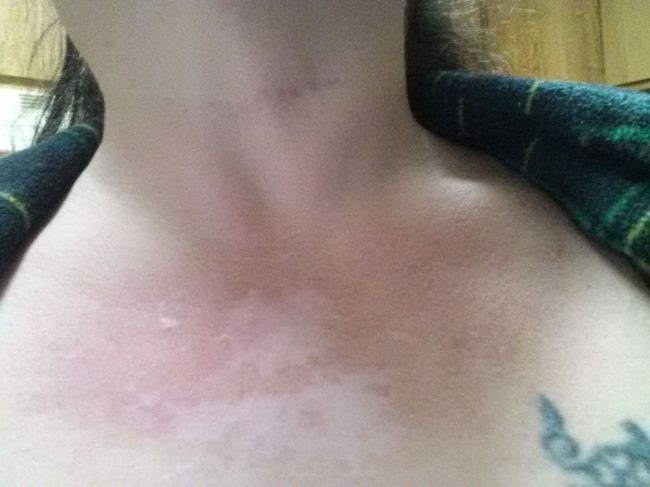It's a little difficult to see in the pic-but I tried to capture not the rash or hives on top of the skin but the bumps underneath the skin. My blood vessels were so inflammed I could follow them up and down my arms-and feel the muscles and nerves of my ulnar and carpal neuropathy being pulled.
The actual term is urticarial vasculitis. It's a hypersensitivity vascular reaction to the UV or the sun-of which many people with lupus have sensitivities with. When mine gets bad-it causes this reaction. I call it a mini-flare-it usually takes about a week to come all the way down, and yes, it ITCHES and yes, it's painful. While I usually have it on my arms, I have had it on my chest and face as well. Here's my chest, only slightly reactive, but still very hot, swollen and itchy:

The discolorations you see on my chest are from previous urticaria rashes, lupus rashes, discoid rashes, lesions and pemphigoid rashes. Here's some info on urticarial vasculitis from medscape:
Urticarial vasculitis is an eruption of erythematous wheals that clinically resemble urticaria but histologically show changes of leukocytoclastic vasculitis.[1, 2] Urticarial vasculitis may be divided into normocomplementemic and hypocomplementemic variants. Both subsets can be associated with systemic symptoms (eg, angioedema, arthralgias, abdominal or chest pain, fever, pulmonary disease, renal disease, episcleritis, uveitis, and Raynaud phenomenon).
The hypocomplementemic form more often is associated with systemic symptoms and has been linked to connective-tissue disease (ie, systemic lupus erythematosus [SLE]).
Patients with urticarial vasculitis present with an urticarial eruption, often accompanied by a painful or burning sensation. Lesions are generalized wheals or erythematous plaques, occasionally with central clearing, lasting for more than 24 hours in a fixed location (in contrast to urticaria, which resolves in minutes to hours or migrates continually). Petechiae may be noted within the lesions, and they may resolve with ecchymoses or postinflammatory hyperpigmentation. Patients may have photosensitivity, lymphadenopathy, arthralgia, angioedema (40%), fever, abdominal pain, dyspnea, and pleural and pericardial effusions.[4] Most cases of urticarial vasculitis are idiopathic.
The primary causes of urticarial vasculitis are as follows:
- Drug induced, such as ACE inhibitors, penicillin, sulfonamides, fluoxetine, cimetidine, diltiazem, thiazides, potassium iodide, non-steroid inflammatory drugs, and glatiramer acetate.[9]
- Rheumatic disease, such as SLE and Sjögren syndrome: Urticarial vasculitis has also been reported with immunoglobulin A and immunoglobulin M monoclonal gammopathies, mixed cryoglobulins, and hematologic and solid malignancies.[10]
- Hypocomplementemia often is associated with a systemic condition, such as SLE (in which >50% of patients have hypocomplementemia).[3] In addition, as many as 71% of patients with hypocomplementemic urticarial vasculitis have a positive antinuclear antibody titer but do not fulfill the American Rheumatism Association criteria for SLE.[5] Some authors have suggested evaluation of hypocomplementemic urticarial vasculitis for immunoglobulin G antibodies to C1q. Individuals with these antibodies have a higher incidence of angioedema, ocular inflammation, glomerulonephritis, and obstructive pulmonary disease.
- Normocomplementemic vasculitis can be associated with connective-tissue disease but at a much lower rate.





